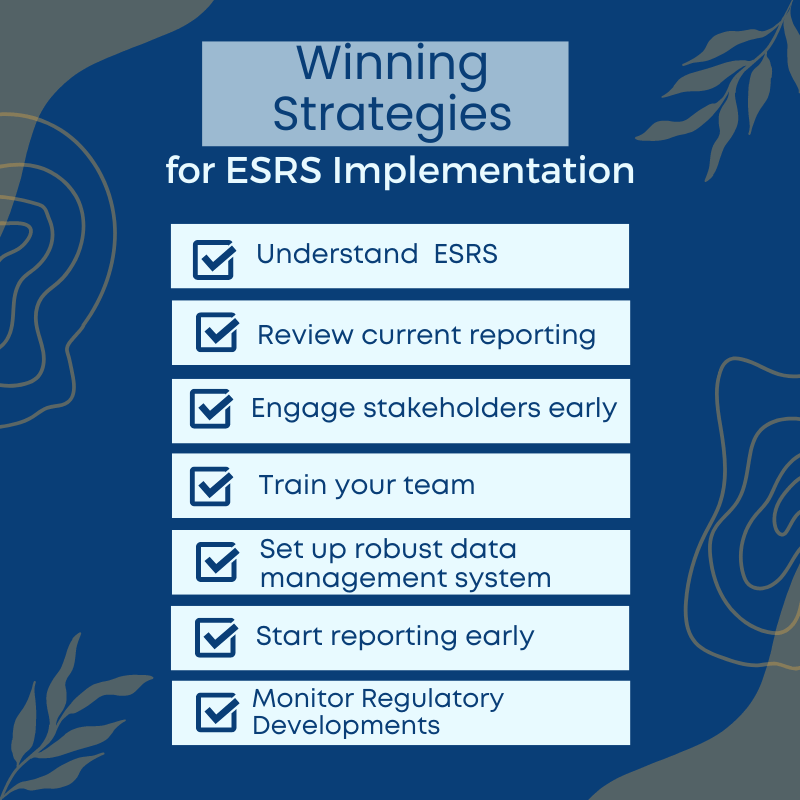The EU Corporate Sustainability Reporting Directive (CSRD) is a game-changing piece of legislation that requires businesses to publish comprehensive sustainability reports. By introducing uniform standards across the EU, it aims to improve the comparability and reliability of sustainability information.
The CSRD requires companies to report on various sustainability or ESG matters to meet the requirements of the Europeaning Sustainability Reporting Standards (ESRS).
In the wake of this regulation, technology emerges as a critical facilitator, significantly aiding corporations in meeting the CSRD requirements. This article delves into how modern technology can streamline the process of compliance, reinforcing its essential role in the evolving landscape of corporate sustainability.
The Complexity of CSRD Compliance
The CSRD encompasses a wide range of non-financial and diversity information, covering environmental, social and goverance (ESG) matters such as employee-related aspects, respect for human rights, anti-corruption, and bribery issues. Complying with these comprehensive ESG reporting requirements poses an undeniable challenge for corporations, often necessitating substantial resource allocation, system modifications, and procedural adjustments. This is especially important to large companies as they will start reporting against the CSRD in 2025 for the financial year 2024. Herein lies the value of technology as a powerful tool for achieving effective and efficient CSRD compliance.
To find out more about what the CSRD is, check out the blog Unpacking the CSRD: A New Paradigm in Corporate Accountability.
Roles Technology Can Play to Facilitate CSRD Compliance

Leveraging Data Analytics for CSRD Compliance
One of the significant challenges of complying with the Corporate Sustainability Reporting Directive (CSRD) is managing the collection, processing, and interpretation of large volumes of data required for sustainability reports. Comapnies, large or small, should recognize the need to collect and disclose various data points as outlined in the European Sustainability Reporting Standards (ESRS). Modern data analytics can be instrumental in addressing this challenge. By utilizing advanced data analytics tools, businesses can extract valuable insights from their sustainability data, providing a robust foundation for their reports.
Machine learning algorithms can analyze patterns and trends across extensive datasets, enabling companies to predict future sustainability outcomes and adjust their strategies accordingly. Predictive analytics can assist businesses in identifying potential areas of risk and non-compliance, empowering them to take proactive action to ensure adherence to CSRD requirements.
The Power of Automation in CSRD Compliance
Given the enormity and complexity of data management for CSRD reporting, automation becomes crucial. Software solutions equipped with automated data collection and reporting capabilities can significantly streamline the process. Automated systems can gather data from multiple sources, consolidate it, and generate reports in formats compliant with ESRS standards. This approach reduces the risk of human error and improves overall efficiency.
Automation also enables real-time tracking and reporting of sustainability metrics, promoting timely decision-making and continuous improvement. By automating repetitive tasks, businesses can allocate resources to strategic aspects of CSRD compliance, such as enhancing sustainability practices and driving innovation.
Harnessing Blockchain for Enhanced Transparency in CSRD Compliance
Blockchain technology, with its secure, transparent, and immutable record-keeping capabilities, has the potential to revolutionize how companies manage and report their sustainability data. Implementing blockchain-based systems can provide a tamper-proof trail of all sustainability-related transactions and actions, greatly enhancing the credibility and reliability of the reported data.
Additionally, by leveraging smart contracts, businesses can automate compliance-related processes, such as verifying the sustainability credentials of suppliers. This not only improves efficiency but also strengthens the integrity of the corporate sustainability value chain, a key requirement under the CSRD.
AI and Natural Language Processing for Compliance Monitoring in CSRD
Artificial Intelligence (AI) combined with Natural Language Processing (NLP) can offer advanced compliance monitoring solutions. AI-powered tools can monitor various data sources, including internal documents and social media posts, to identify potential compliance issues, thereby alerting companies to take corrective action promptly. NLP enables systems to understand and interpret human language in documents and communications, ensuring a comprehensive compliance review. For example, NLP technologies can support companies to improve the effectiveness of their stakeholder engagement efforts.
Conclusion
In the face of increasingly stringent sustainability reporting requirements, such as the CSRD, technology is a powerful ally for corporations in measuring, reporting and monitoring their sustainability performance. Data analytics, automation, blockchain, AI, and NLP offer innovative solutions to the complex challenges of CSRD compliance. These technologies can also help companies to use the same data for reporting against different reporting frameworks, expanding their use to more than just to comply with the CSRD.
Having centralized data collection and analytics processes will make the assurance of sustainability reports more efficient. Auditors and audit teams can easily access and verify many CSRD/ESRS requirements by using the collected and analyzed data.
By adopting these technologies, businesses can not only meet the regulatory demands more efficiently but also drive their sustainability agenda more effectively, turning compliance from a daunting task into a strategic advantage.
However, it is crucial to remember that while technology is a powerful tool, its effectiveness relies on the strategic vision, commitment to sustainability, and implementation skills of the human resources within an organization. As such, the successful deployment of technology for CSRD compliance requires a delicate balance of technical capabilities and human ingenuity. As we move into a future where sustainability reporting becomes increasingly paramount, harnessing the power of technology will be key to remaining ahead of the curve.
Your Next Steps With CSRD and ESRS Sustainability Reporting
Get ready to lead the way towards a sustainable future with CSRD and ESRS Sustainability Reporting. Don’t wait any longer – it’s time to take action and position your company for success. Familiarize yourself and your team with the CSRD and ESRS reporting requirements today to ensure effective compliance and gain a strategic advantage in this evolving landscape.
Feeling overwhelmed? Don’t worry, you’re not alone. We’ve got you covered with a wealth of resources available on The CSRD Compass website. Explore in-depth guides, explanatory articles, comprehensive courses, and expert analyses all in one convenient place. The CSRD Compass is your ultimate destination for everything related to CSRD and ESRS.
Together, let’s embark on this transformative sustainability reporting journey, future-proof your business, and make a positive impact on our world. Your first step starts here, with The CSRD Compass.


